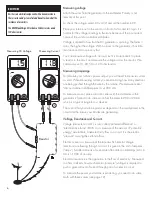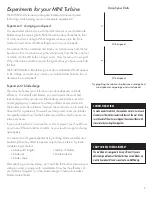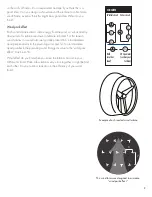
12
The power of wind farms
Recall the Power in the Wind equation:
P = ½
ρ
(
π
r
2
) V
3
What are we changing in this equation when we add wind turbines and
create a wind farm? The density of the air will not change. Adding more
turbines will not change the wind velocity, either. The part of the equation
you are changing is the swept area (r).
Advanced Calculations
Determining the power output of your KidWind MINI
These calculations are more advanced than just measuring voltage or
current alone and require you to have learned how to use your multimeter
properly. During these calculations, be mindful of the units to which your
multimeter is set. Make sure it is set to volts or amps, rather than millivolts
or milliamps. If you do not use the correct units, your calculations will
come out wrong.
The equation for electrical power is shown below:
P = V × I
P = Power in watts
V = Voltage in volts
I = Current in amps
Example:
Your MINI Wind Turbine is producing 3v at 50mA. How much power is
your turbine producing?
P = V × I
P = 3 × .050 A
P = .15 watts
Ohm’s law
Using Ohm’s law, multimeter measurements, and resistors, we can do
some simple calculations to determine current output. The foundation of
these basic electrical computations is referred to as Ohm’s law, after the
German physicist George Ohm. In 1827, Ohm described measuring
voltage and current through simple electrical circuits containing various
lengths of wire.
Ohm’s law:
V = I × R
V = voltage in volts
I = current in amps
R = resistance in ohms
Typical output for the MINI:
Voltage: 1–4 volts
Amperage: 20–100 milliamps (.020–.1 amps)
If your numbers have come out much higher than this,
something is amiss. Check your units!
TYPICAL OUTPUT
Summary of Contents for MINI Wind Turbine
Page 1: ...MINI Wind Turbine Instruction Manual...
Page 13: ...15...














